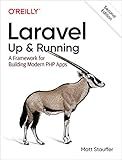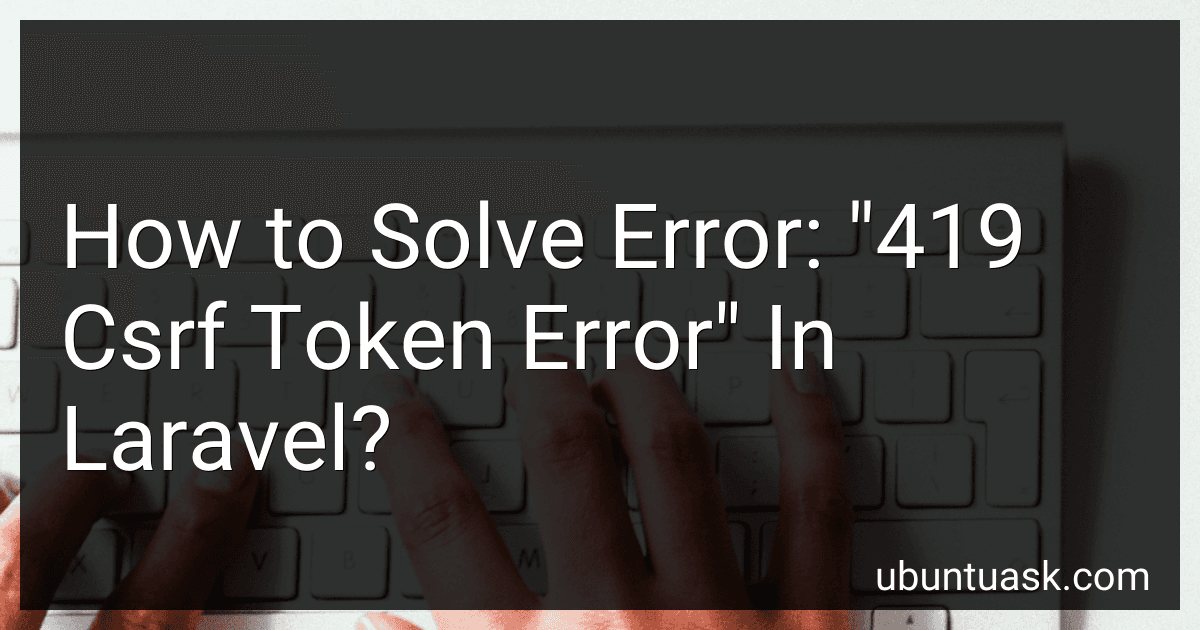Best Laravel Error Solution Guides to Buy in December 2025

Laravel: Up & Running: A Framework for Building Modern PHP Apps



Laravel: Up & Running: A Framework for Building Modern PHP Apps



Ultimate Laravel for Modern Web Development: Build Robust and Interactive Enterprise-Grade Web Apps using Laravel's MVC, Authentication, APIs, and ... (Advanced Web Frameworks — Multi-Tech Path)



Practical Laravel: Develop clean MVC web applications



Mastering Laravel 12 : Advanced Techniques for Modern PHP Development



Laravel 12 for Beginners & Beyond: A Complete Guide to Building Modern PHP Web Applications with Clean Architecture, Hands-On Projects, and Best Practices


To solve the "419 CSRF token error" in Laravel, you can try the following steps:
- Make sure that your form has the @csrf directive in the Blade file. This generates a hidden CSRF token field in the form.
- Check if the CSRF token is being sent with the form submission. You can do this by inspecting the form data in your browser's developer tools.
- Verify that your CSRF middleware is enabled in the VerifyCsrfToken middleware class. This middleware checks if the CSRF token in the form matches the one stored in the session.
- Clear your browser cookies and cache. Sometimes, the CSRF token error can occur due to outdated or incorrect cookies being stored in your browser.
- Check for any JavaScript errors that might be preventing the CSRF token from being included in the form submission.
By following these steps, you should be able to resolve the "419 CSRF token error" in Laravel and ensure that your form submissions are secure.
How to refresh the CSRF token in Laravel?
In Laravel, the CSRF token is automatically refreshed every time the user visits a page that contains the CSRF token. However, if you want to manually refresh the CSRF token in Laravel, you can do so by following these steps:
- Create a form in your blade template that contains the CSRF token:
- Add a button or link that triggers a POST request to the server to refresh the CSRF token:
Refresh Token
- Use JavaScript to submit the form when the button is clicked and fetch a new CSRF token from the server:
document.getElementById('refresh-token').addEventListener('click', function() { fetch('/refresh-csrf-token', { method: 'POST', headers: { 'X-CSRF-TOKEN': document.querySelector('meta[name="csrf-token"]').content } }).then(response => { if (response.ok) { // CSRF token refreshed successfully window.location.reload(); // reload the page to update the CSRF token } else { console.log('Failed to refresh CSRF token'); } }); });
- Create a route and controller method in your Laravel application to handle the request to refresh the CSRF token:
Route::post('/refresh-csrf-token', 'CsrfTokenController@refreshCsrfToken');
// CsrfTokenController.php public function refreshCsrfToken() { return response()->json(['message' => 'CSRF token refreshed'], 200); }
By following these steps, you can manually refresh the CSRF token in Laravel when needed. Please note that refreshing the CSRF token manually may not be necessary in most cases, as Laravel handles the CSRF token expiration and regeneration automatically.
How to safely pass CSRF tokens between different pages in Laravel?
One way to safely pass CSRF tokens between different pages in Laravel is by using the csrf_field() helper function that Laravel provides. This function generates an HTML hidden input field containing the CSRF token value, which can be included in forms on different pages.
Here's an example of how to include the CSRF token in a form in a Laravel blade template:
Laravel automatically checks the CSRF token value when a form is submitted, so you don't need to manually validate the token. This helps prevent CSRF attacks.
You can also pass the CSRF token value in AJAX requests by including the X-CSRF-TOKEN header in the request headers. Here's an example using jQuery:
$.ajax({ url: '/submit-form', type: 'POST', headers: { 'X-CSRF-TOKEN': $('meta[name="csrf-token"]').attr('content') }, data: { // Data to be sent in the request }, success: function(response) { // Handle success response }, error: function(xhr, status, error) { // Handle error response } });
By including the CSRF token value in forms and AJAX requests, you can securely pass CSRF tokens between different pages in your Laravel application.
What is the syntax for adding a CSRF token in Laravel forms?
In Laravel, we can add a CSRF token to our forms by using the @csrf directive or csrf_field() helper function.
Syntax using @csrf directive:
Syntax using csrf_field() helper function:
Both of these methods will add a hidden input field with a CSRF token generated by Laravel to protect against CSRF attacks.
How to integrate CSRF token validation with Laravel validation rules?
To integrate CSRF token validation with Laravel validation rules, you can follow these steps:
- Add the CSRF token field to your form using the csrf_field() helper function in your Blade template.
- In your controller method where you handle form submission, include the csrf middleware to automatically validate the CSRF token. You can do this by adding the VerifyCsrfToken middleware to the $middleware property in app/Http/Kernel.php or by using the middleware method in your controller constructor.
- To include the CSRF token validation in your custom validation rules, you can create a new rule using the Rule facade provided by Laravel. For example, you can create a custom rule to check the CSRF token as follows:
use Illuminate\Support\Facades\Hash; use Illuminate\Validation\Rule;
class CustomValidationRules { public function validateCsrf($attribute, $value, $parameters, $validator) { return Hash::check($value, csrf_token()); } }
- Register your custom validation rule in the boot method of the App\Providers\AppServiceProvider class:
use Illuminate\Support\ServiceProvider; use Illuminate\Support\Facades\Validator;
class AppServiceProvider extends ServiceProvider { public function boot() { Validator::extend('csrf_token', 'App\CustomValidationRules@validateCsrf'); } }
- Now you can use the csrf_token rule in your validation rules array, like this:
$validatedData = $request->validate([ 'name' => ['required', 'string'], 'email' => ['required', 'email'], '_token' => ['required', 'csrf_token'], ]);
By following these steps, you can integrate CSRF token validation with Laravel validation rules in your application.
